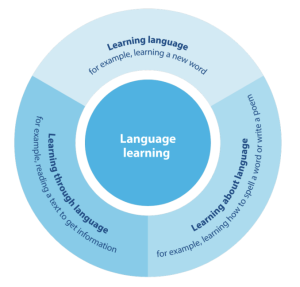Language Policy
1. Purpose of the Language Policy
The purpose of the Language Policy is to:
Achieve a common understanding of our aims and objectives for language learning and teaching.
Explain how to meet the diverse needs of our students in their language acquisition.
Create a working document that will help guide staff in their practices.
Clearly communicate the language programs offered at FA in both the PYP and MYP programs.
2. Language Philosophy
At FA, all teachers are language teachers and all students are language learners.
Each student has his or her own linguistic background, making unique contributions to our learning community as a whole. Recognizing this is crucial for defining cognitive development and maintaining cultural identity.
At FA we commit to provide a learning community that promotes and supports language development in a multilingual environment. Our goal is to foster international-mindedness while learning a new language and valuing the student’s home language.
We support the IB belief that:
“All students bring a significant body of language knowledge to school with them; knowledge about language and the way it works, knowledge about learning language, and knowledge of the social role of language.”
We welcome and recognize each student’s unique identity as a language learner and embrace the aspects of language learning as shown in the infographic below.

3. Support for Home and Family Languages and Support of Regional Language and Culture
In all programs, initiatives, and events, FA is conscious of and responsive to our diverse community.
We recognize the importance of supporting students’ home language as well as the regional languages and cultures that enrich our society.
This commitment is evidenced in the following:
Encouraging the maintenance and development of home languages.
Providing free simultaneous Arabic interpretation at all community events.
Translating all written communication to parents and community into Arabic.
Offering translators for conferences and meetings when needed.
Employing multiple Arabic/English bilingual teaching and support staff.
Hosting multiple cultural events and celebrations throughout the year.
Stocking libraries with a variety of Arabic-language resources.
Providing laptops for primary and middle school students to support translation needs.
4. Language Learning in the Elementary School Setting (K–5)
FA emphasizes learning through language.
Language is fundamental to learning, thinking, and communicating, and plays a central role in the curriculum.
To create a multilingual learning environment and foster global awareness and understanding, we introduce Arabic as a second language in the primary grades. Arabic instruction is provided five times a week, enabling students to participate actively while gaining confidence in the new language.
5. Student Support for Multilingual English Language Learners
To support Multilingual English Language Learners, FA provides the following:
GLAD (Guided Language Acquisition Design) strategies to support English Language Development and access to curriculum content.
Integrated English language instruction for all students.
Daily designated English language instruction for English language learners.
Classroom differentiation to meet diverse needs.
Small group Tier 2 push-in support and online tutoring by Literacy Specialists for students requiring additional help.
6. Staff Support
Arabic Team Meetings for coordination and planning.
Collaboration between elementary and middle school language teachers regarding curriculum, assessment, and exam preparation.
Regular meetings between English and Arabic language teams to plan instruction in subjects taught in both languages.
7. Assessment
The purpose of assessment in language acquisition is to:
Determine students’ strengths and growth areas.
Guide meaningful instruction.
Improve student learning.
Inform stakeholders.
Students demonstrate their language knowledge through diverse methods including oral presentations, exhibitions, performances, and multimedia presentations in both languages.
Multiple standard measures are used to assess language proficiency in grades K–5.
8. Language Learning in the Middle School Setting (Grades 6–8)
Students have the opportunity to learn Arabic, recognizing that each student is on an individual language journey.
Our goal is to help every student reach their highest possible IB phase of second-language acquisition and/or language and literature.
Language serves as a tool for inquiry, global thinking, and communication.
9. Students Who Are Not Yet Proficient in English
Students who have not yet reached proficiency in English receive additional support inside the classroom.
English and math academic support is provided by specialists using a push-in model.
10. Language Acquisition Offerings and Pathways
At the start of each academic year, students take an Arabic language proficiency placement test to determine their phase of language acquisition.
New students enrolling mid-year also take the placement test.
FA offers three levels for students from different language backgrounds:
Level 1 & 1+: Beginner
Level 2 & 2+: Intermediate
Level 3 & 4: Advanced
This Language Continuum ensures instruction meets individual needs and supports progression in both Arabic and English.
11. Policy Review
Falcon Academy’s Language Policy is reviewed annually by the learning community.
12. References & Acknowledgment
This policy reflects IB-aligned language learning practices.
It adapts structures and language from publicly shared IB language policies while tailoring them to Falcon Academy’s context, academic support, and Arabic pathways.